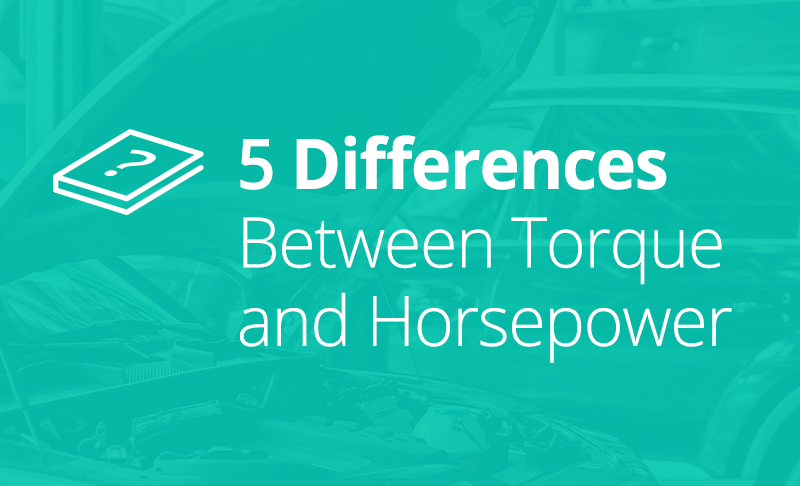
Torque Vs. Horsepower
There are five key differences between torque and horsepower to know if you’re buying a new or used car. This guide highlights how to tell torque and horsepower apart and why they matter for your next vehicle purchase.
When you’re buying a new or used vehicle, you’ll likely want to take a look at what’s under the hood. Understanding the differences between torque and horsepower is helpful for making a final buying decisions. Here’s what you need to know about the two as you navigate your car-buying journey.
KEY TAKEAWAYS
Here’s a little background on what torque and horsepower actually are. Both are basically a byproduct of your car’s engine when you turn on the ignition and hit the gas. They’re a part of the process involved in converting the air and fuel within the engine into the energy needed to make your car move.
Torque measures the turning force produced by your car’s engine and its ability to perform work, whereas horsepower measures how fast your engine can perform the work. In other words, high torque will make your engine accelerate faster after stopping, and high horsepower will create a higher top speed.
WHAT IS HORSEPOWER?
Horsepower (also known as “hp”) is how much power a vehicle engine can create. Another way to describe it is the amount of work an engine can do in a certain amount of time. Horsepower came to be used as a unit of measurement in the 18th century by James Watt, a Scottish inventor and engineer. He compared the output of steam engines to horses.
One horsepower is equal to 33,000 foot-pounds of work/minute—or 550 foot-pounds of work/second.
WHAT IS TORQUE?
Torque is a measure of rotational force. More specifically, it’s defined as the amount of force required to rotate an object around an axis. It’s often called the “grunt” of an engine because it dictates the engine’s ability to perform work.
You know that feeling when the force of the engine propels your vehicle forward and you get slammed back into your seat? That’s torque. The force created by the engine spins the crankshaft and the transmission sends this torque to the wheels. This moves the vehicle—the more force that gets applied to the crankshaft, the more work the vehicle is capable of.
5 Differences Between Torque and Horsepower
Now that we’ve gotten that down, let’s look a little closer at the differences between torque vs. hp for acceleration:
1. They measure different things
Simply put, torque is a way to measure force. Specifically, it’s a measurement of the rotational force within your car’s engine at the crankshaft.
Horsepower, on the other hand, measures the amount of power that’s transferred from the engine to the wheels. This measurement is based on the weight of the object that’s being moved (in this case, your car), the distance it moves, and the time in which it covers that distance. A simple way to calculate horsepower is to multiply torque by rotations per minute or RPMs/5252.
2. They work differently for vehicle acceleration
When you press the gas pedal, your vehicle moves through a combination of torque and horsepower. But in terms of how they help you accelerate, they each have their own function.
In a nutshell, it’s torque’s job to get your car moving when you initially accelerate. Once the car is going, it’s horsepower that helps you get up to and maintain speed for your drive.
3. Torque is more important for towing
If you routinely haul trailers, campers, boats or anything else, then torque is what matters for reducing strain on your vehicle and pulling the load.
Torque is what helps your vehicle start and navigate hills and it can be more powerful than horsepower for keeping your engine running smoothly when you have a heavy load. A higher torque vehicle, such as a heavy-duty truck, may take more time to accelerate but it’s the low-end power nature of torque that makes hauling possible
4. Horsepower is all about vehicle performance
High-horsepower vehicles are designed for drivers who want speed and power under the hood. The higher a vehicle’s horsepower rating, the faster it’s likely to go, relative to its size.
A sports car, for example, may outpace a large sedan even if it has the same horsepower rating it the sports car is lighter or more compact. A car with more horsepower could also offer better handling on the roads.
Vehicles with higher horsepower ratings do still rely on torque, however. These cars are designed to have the right balance between torque and horsepower for the best driving experience possible.
5. Torque and horsepower are not equal for fuel efficiency
The last difference between torque and horsepower may be the most important to you if you want a vehicle that’s as fuel-efficient as possible.
Both affect fuel efficiency but in different ways. The more horsepower a car has, the faster it’s going to burn fuel, both on acceleration and under normal driving conditions. Conversely, the more low-end torque a vehicle has, the slower it may burn fuel, depending on your typical driving and hauling habits.
THE RELATIONSHIP BETWEEN HORSEPOWER & TORQUE
The relationship between horsepower and torque is a close one. The amount of horsepower an internal combustion engine can create is directly related to the amount of torque generated by the crankshaft—and the crankshaft is directly related to the total displacement (or size) of the engine and its peak RPM.
So, a car with more horsepower can maintain high speeds longer. Meanwhile, a car with more torque can accelerate more quickly from a standstill. Engine tuners typically try to optimize both.
High-torque engines with a larger engine size tend to have higher output at lower RPM, while engines with higher RPM will tend to have higher horsepower output. Because there is a limitation on the engine size for different-sized vehicles, there is also a maximum torque limit the engine can produce. This, in turn, also means there’s a limit on the engine’s maximum horsepower.
HOW HORSEPOWER & TORQUE ARE MEASURED
As we mentioned earlier, torque and horsepower are easily measured with the formula:
Horsepower = Torque x Engine RPM / 5252
If you plug in various RPM values into this equation, you can get an idea about the range of power an engine can produce. Engine builders use this formula to measure the values and relationship between torque and horsepower on a dynamometer. Torque and horsepower will always intersect on a dyno map because they will always be equal when the engine speed is 5252 RPM.
CONCLUSION
One last thing to note is that the amount of torque and horsepower a vehicle has can affect the rate of wear and tear it experiences. That’s important to know if you’re planning to sell at some point and you want to maximize resale value. If you’re in the market for a new or used vehicle, consider Birchwood Credit Solutions’ wide inventory selection to find the right combination of torque and horsepower.
At Birchwood Credit Solutions, we’re committed to helping you get financing for your car-buying needs. We serve a variety of customers, including newcomers to Canada as well as people of all credit backgrounds. To get started with financing today, complete our online application to find a vehicle that works for your budget and lifestyle.



